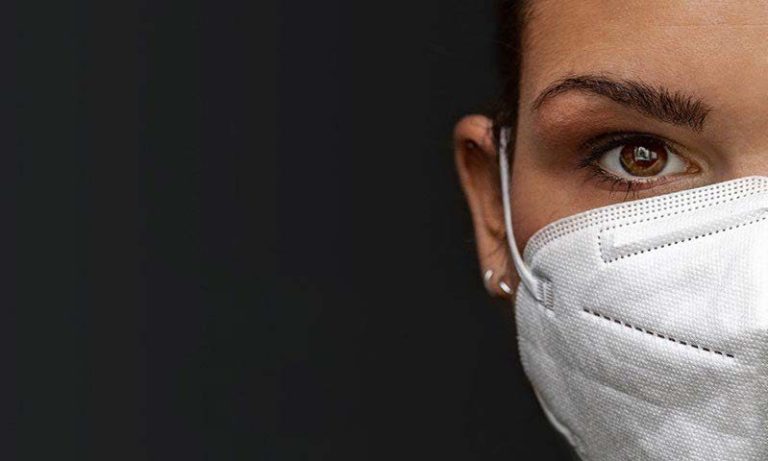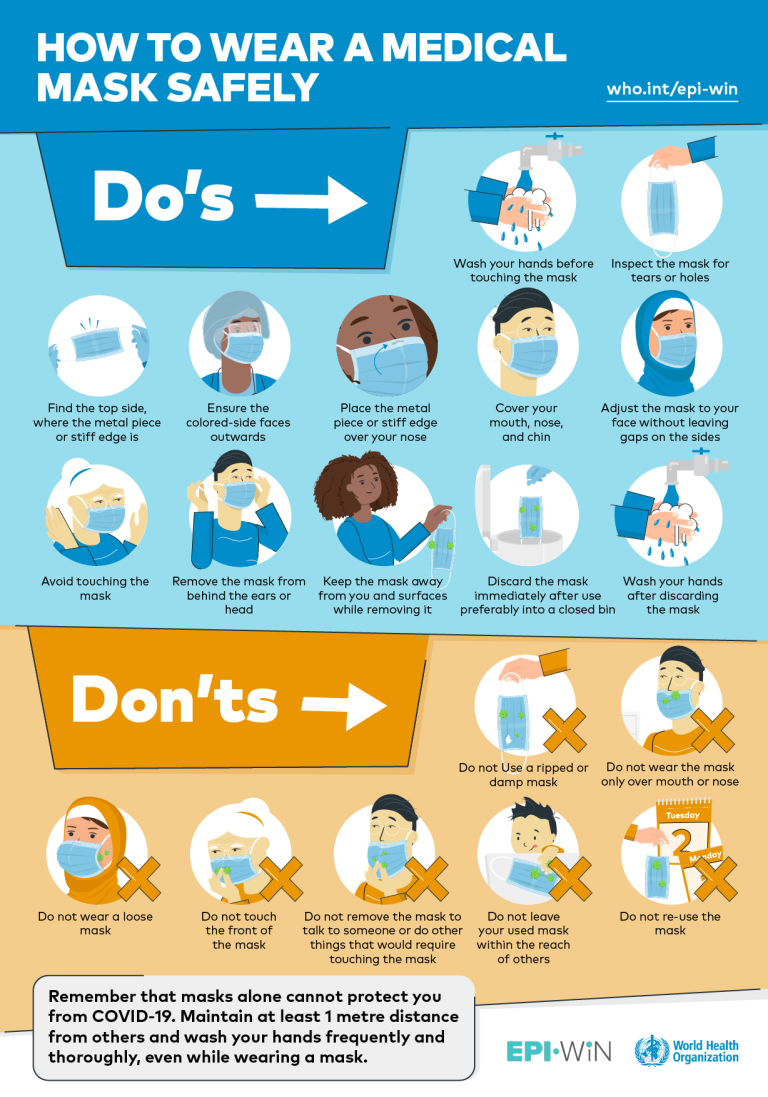
Explainer Content: Masks
As Accenture began returning to the office, the company wanted to remind employees to wear masks. It was 2022, and people had had enough of reminders.
But Accenture employees are intellectually curious. I knew they couldn't resist an article about how masks work. We wouldn't have to tell them to wear masks at all. They'd get the point just by satisfying their curiosity.
The resulting "explainer" ended up being the most popular story of the year.
(The pandemic's importance led me to take the unusual step of writing some content myself, rather than assigning them to my team. This is one.*)
What You Should Know About Masks
By Julie Roth | 14 January 2022
Remember the early days, when there weren’t enough masks to go around, and we had to leave them for healthcare workers? Then the home seamstresses of the world came to the rescue, creating millions of cloth masks to protect us.
Then the mask supply finally caught up, and it became easier to get surgical masks, carbon mask inserts, N95s, KN95s, KF94s and FFP2s.
So, what kind of mask should we be wearing now? Does it matter?
Why now
The question of masks is coming up again because the Omicron variant is so much more contagious — about 2.7 to 3.7 times more than the Delta variant, even to vaccinated people. If masks were important before, they are all the more so now.
And we know that masks work. A November 2021 study found mask-wearing reduced new COVID-19 infections by 53% all by themselves.
Why respirator masks are best
Yes, some masks are better than others. And the best are respirator masks: N95, KN95, KF94, FFP2 or DS. Here’s why.
Secure fit
We’ve all seen masks that gape on the sides or slip down off someone’s nose. Obviously, those gaps aren’t stopping anything.
The most important thing, says Dr. Piot, is to wear a mask that fits snugly over your nose and mouth.
Unlike cloth or surgical masks, respirator masks are designed to form a tight fit around the face so particles can’t escape around the edges. Just make sure the fit is secure before you go out in public.
You’re wondering about beards, aren’t you? Yes, beards keep a mask from fitting securely around a face. Even so, respirator masks still provide the best protection for bearded men.
Filtration
Respirator masks have another advantage. Their dense fiber network blocks 99.8% of Covid-sized particles.
Cloth masks block only 50%-70% of fine particles, even when they fit tightly. That’s because the pores of cloth masks are hundreds of times larger than Covid particles (80 to 500 micrometers vs. 0.1 micrometer).
And even surgical masks are only made to protect you from large particles like droplets and sprays.
Reuse
The U.S. Centers for Disease Control says you can reuse respirator masks — as long as they’re not broken and don’t have bodily fluids on them.
But, first, make sure they’re clean in one of these two ways:
- Place a mask into a paper bag for at least 3-4 days at room temperature.
- Heat the mask for 60 minutes at 70°C (158°F).
How to spot a counterfeit mask
Real respirator masks meet strict testing standards from various governments:
- N95 – United States
- KN95 – China
- KF94 – South Korea
- FFP2 – Europe, Brazil
- DS – Japan
But counterfeits abound. In the U.S., for example, the American Medical Association says about 60% of KN95 respirators are counterfeit.
As with most purchases, buying from a reputable seller is the first step, for example your usual trusted pharmacy or ordering directly from a legitimate manufacturer.
When your masks arrive, the packaging should have an expiration date and say where the masks where manufactured.
Once you have your mask, one way to tell if it’s legitimate is to make sure it has the right kind of number on it:
- N95s – Look for “TC”, two numbers, a letter, four numbers, then a lot number
- KN95s – Look for “GB 2626-2019”, then a space, then KN95
- KN94s – Look for the South Korean government’s red, white and blue seal, the text 식약처 허가 or “certified by the Ministry of Food and Drug Safety, South Korea”
- FFP2s – Look for the manufacturer name, model number, EN standard number, CE certification and facepiece class
(The British Occupational Hygiene Society has prepared a detailed document with pictures to help you know what to look for in counterfeit masks.)
If you can’t get one of those
So, what do you do if you can’t find a real N95, KN95, KF94 or FFP2?
One tactic is to wear two masks. You can make a surgical mask more effective by wearing a multi-layered cloth mask over top so it fits more tightly to your face. (Just don’t combine respirators with other masks.)
And Dr. Piot says the less effective your mask is, the more attention you should pay to other protection tactics:
- Put more distance between yourself and others.
- Meet outside or at least open windows when with others.
- Limit the amount of time you are with groups of people.
Why respirator masks work so well
For those of you who are into the science of it, here’s why respirator masks work so well.
N95, KN95, KF94 and FFP2 masks all stop particles 0.3 microns or larger — N95s and KN95s stop at least 95% of them; KF94s and FFP2s stop at least 94%.
Even though they’re standardized to that 0.3 micron size, the masks are even better at filtering out smaller particles. The N95s, for example, filter about 99.8% of 0.1-micron particles — the size of COVID-19 particles.
They’re able to do this because of the science behind how they’re made. N95, KN95, KF94 and FFP2 masks are all constructed with layers of synthetic material, typically non-woven polypropylene fiber. Because particles smaller than 0.3 microns move in a haphazard way called “Brownian motion,” they bump into one fiber or another within the mask and are caught.
But these masks leave nothing to chance. They also use electrostatic absorption — a force like static electricity — that attracts and grabs the particles. (There’s a great video explaining this on YouTube.)
Know more
- See the World Health Organization’s video, Find a mask that fits your face the best
- See the World Health Organization’s infographic, How to wear a mask safely
- Send your questions for Dr. Piot and Dr. Tam to AskDrP@accenture.com. [internal link]
- See more COVID-19 guidance from Dr. Tam and Dr. P. [internal link]
- You can now share our Luminary Voices playlist with your family and friends. Find us on YouTube.
___________________________________
Accenture is providing this to inform our employees and broader community of the risks surrounding COVID-19 and guidance on testing and vaccines related to the virus. It is intended for informational purposes only and is not a substitute for professional medical advice, diagnosis or treatment. Please consult a healthcare professional for any specific medical advice you may require. Accenture does not take responsibility for the accuracy or timeliness of the information contained herein.
* Some links in this article may no longer work so long after publication.
© Copyright 2022 Accenture, used with permission


By World Health Organization, CC BY-SA
3.0 IGO, CC BY-SA 3.0 igo. Click image to enlarge.
© Copyright 2025 Julie C. Roth. All rights reserved.
We need your consent to load the translations
We use a third-party service to translate the website content that may collect data about your activity. Please review the details in the privacy policy and accept the service to view the translations.

